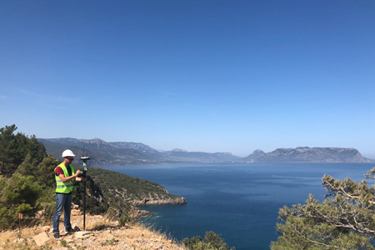A Career In GIS: How To Create More Opportunities For The Next Generation
By Luis Olivieri, Lawrence Burden, Le’Aundra McCullough, and Ashley Pena

Whether for water quality, conservation, governance, stormwater management, resiliency, or a host of other needs, geographic information systems (GIS) are in demand, presenting an excellent opportunity to grow — and diversify — your workforce.
Geographic information systems (GIS) is a field that has become an essential tool in many industries, and the skills required to be a successful GIS professional have evolved over the years. There are a variety of ways organizations utilize GIS technologies, such as sharing information, communicating data, and performing analyses. However, the industry is dealing with the challenge of young adults not knowing what GIS is and how to secure a career in the field.
Raising Awareness About GIS
When it comes to choosing a career path, there is a lack of awareness and understanding on how many doors a geography degree can truly open. However, in order for the industry to continue creating a pipeline of successful GIS professionals and have a strong retention rate, there needs to be more exposure to the field and how GIS impacts so many different industries.
- Making GIS More Easily Understood: Those in the GIS field face challenges in raising awareness about what GIS is, as well as its value and benefits, because not everyone is familiar with what GIS can do, how it works, or why it matters. The first step utilities, businesses, and organizations can take is to explain GIS in simple terms by using examples or stories through interactive tools, such as web maps, that allow your audience to explore the data themselves. This can help them engage with the data, ask questions, and discover insights. You could also use videos, podcasts, or blogs that showcase how GIS is used in different fields, industries, or contexts.
- Providing Hands-On Experience Through Partnerships: GIS impacts real-world situations, so real-world experience is invaluable. Hopeworks — a social enterprise based in Camden, NJ, that uses technology, healing, and entrepreneurship to transform lives — partners with corporations to provide young adults with real-world experiences in the GIS field that they would not have been exposed to otherwise.
Several years ago, Hopeworks partnered with New Jersey American Water to assist with its GIS needs. When the partnership began, Ashley Pena served as an intern with the project. Since then, she has been able to expand her expertise in the field and inspire other young adults to learn more about GIS and pursue a career in the industry. Before arriving at Hopeworks, Ashley did not know what GIS was, but through this partnership and providing hands-on experience, she found a career she is passionate about.
How Can We Create More Opportunities For The Next Generation?
- Looking Past the College Degree: In the past, most employers who were looking for GIS employees were focused on finding a candidate with a degree from an accredited university with a strong understanding of GIS. Over time, these employers started noticing that not all of their GIS personnel needed a higher education, but instead should be employees who could be trained for specific jobs, such as field data collection and data processing. Now, they are looking for candidates with a strong work ethic whom they can train according to their needs, taking them to a level that can be productive and meet their requirements.
Hopeworks has developed a new pipeline to provide these candidates by taking young adults to the next professional level and furnishing them with the necessary skills and training. By doing this, those young adults are not just capable of finding better jobs but also of keeping those jobs.
Innovative organizations across the nation who have talent needs should be thinking about other workforce pipelines to find their candidates, rather than going the traditional route of accepting an individual with a degree and some experience in the field.
- Identifying Opportunities for Women and BIPOC Individuals: Investing and identifying opportunities to develop women and BIPOC (Black, Indigenous, and People of Color) individuals’ workforce skills will build a more resilient and adaptable workforce. Companies and municipalities need to ensure there are meaningful and different pathways that will lead to high-quality jobs and a supply of workers who have mastered the skills necessary to succeed.
Retention of women in the industry is often hindered by a lack of proactive policies and an inequitable environment. Women are also not always offered the same opportunities as their male counterparts, which is an additional challenge to retention. This can be addressed by increasing training opportunities and offering mentorship programs.
- Establish Mentorship Programs: Establishing a mentorship program provides the opportunity to have experienced GIS professionals guide and inspire young adults who are interested in pursuing a career in the GIS field. The mentors can provide real-world experience and advice that can be instrumental in developing their skills and shaping the future.
Building A Career In GIS Through Workforce Development Programs
GIS has become an essential tool across various industries, from urban planning and environmental conservation to health services and transportation. Building a career in GIS can offer promising opportunities, especially with the rising demand for spatial data analysis and geospatial intelligence.
Choosing to build a career through workforce development programs offers unique benefits, including practical training, mentorship, and connections to employment opportunities. These programs are designed to equip individuals with the necessary skills for specific job roles in the market, such as GIS technician, GIS analyst, and so on. Alongside the theoretical knowledge, practical applications are emphasized.
Hopeworks created a GIS program as part of its business, providing young adults the opportunity to learn basic concepts of GIS through training and real-world experience through their partnerships, such as New Jersey American Water and the city of Camden. The young adults also get the opportunity to utilize ESRI software for their projects. When the young adults enter Hopeworks, they may not have awareness of the GIS field, but through the program, they learn what it is and what they can expect if they pursue a career in the field. In addition to learning about GIS, they learn about the skills and strengths they need for any career path, such as responsibility, how to talk to their supervisors, paying attention to detail, following detailed and complex instructions, critical thinking, and problem solving. When Hopeworks’ young adults apply for a job, all this puts them ahead of other candidates and makes them more appealing to potential employers.
Several years ago, the U.S. Department of Labor identified geospatial technologies,1 which includes GIS, remote sensing, and global positioning systems (GPS), together with biotechnologies and nanotechnologies, as the three fastest-growing technologies. The opportunity is now. It is a great time for young adults to engage with a career in GIS — the tools are more accessible and more powerful than ever. And with technology capable of processing and analyzing increasingly complex data sets, the GIS employees of the future can address challenging problems of both small and large scales more effectively.
References:
About The Authors

Luis Olivieri is the director of GIS at Hopeworks in Camden, NJ, a nonprofit that for over 20 years has used an advanced training curriculum, working with youths 17-24 to get them back in school and find a safe pathway to their future. He has worked for 16 years as a professor in the areas of GIS, remote sensing, and GPS at different universities and colleges, including the University of Puerto Rico at Mayaguez and Rowan University.

Le’Aundra “Lily” McCullough is currently a Hopeworks GIS team lead. During her two years in this position, she has worked to ensure the completion and accuracy of projects. Starting out as a trainee at Hopeworks in 2013, Lily completed internships in the web department and GIS, gaining the experience that allowed her journey to come full circle and become a full-time staff member.

Lawrence Burden, senior director of career programing at Hopeworks, is an experienced coach, youth development professional, and organizational leader. He leads the Hopeworks youth development team and was recently recognized by Governor Phil Murphy for his expertise by being selected for New Jersey’s prestigious Workforce.

Ashley Pena is a GIS analyst for New Jersey American Water, the state’s largest water and wastewater services provider. She joined the company in 2021, after serving as a GIS intern with New Jersey American Water through its partnership with Hopeworks since 2020. Ms. Pena served as a GIS intern and trainee with Hopeworks for a total of four years. In addition to receiving career and technical training through Hopeworks, Ashley attended Camden County College. She is a Camden resident.
